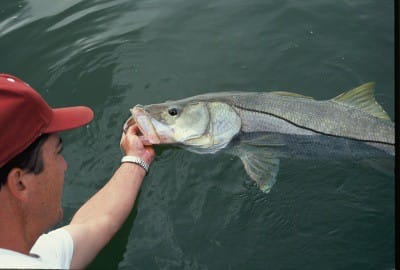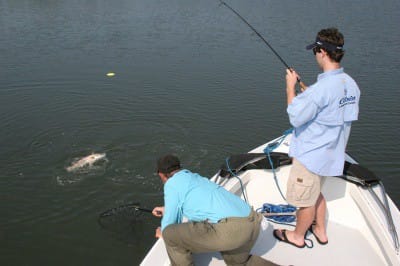
The water was rippled, sun in my face, and it was a long cast into a stiff Gulf of Mexico wind. But a school of shallow-water cobia has a way of making anglers step up to the bar. Adrenalin, they call it.
So I leaned into the cast with everything I had. The ½-ounce leadhead with 6-inch all-black soft plastic tail somehow sailed straight and low over the surface of Tampa Bay, plopping down to the approximate spot where Captain Joel Brandenburg and I figured the circling school of cobia should be.
I engaged the reel, started a snappy retrieve, felt a solid hit, and set the hook hard once, twice for good measure. The rod bent tight and 10-pound test line ripped off the spinning reel as a strong fish took line.
“Got ‘im,” I said proudly to Joel. But he didn’t reply. The cobia he’d hooked from the same school was giving him all he could handle, too.
For a few minutes we struggled to keep lines from crossing. Our pair of cobia stubbornly tried to stay with the school of a half-dozen fish Joel had located near a submerged rock pile in a shallow region off Tampa Bay’s southeast shore. But our fish eventually wore down, and while I danced around the boat with my fish still in charge of the fight, Joel drew his cobia close, unhooked and released it.
“If you get that fish in sometime this morning, we might still find the school again and catch a couple more,” he chided me as I tried to bring the cobia near.
I didn’t waste words on his dig, but hauled back strongly on the rod and finally muscled my cobia to his outstretched hands. Joel latched onto the fish with a BogaGrip and lifted it high for a couple quick photos.
“Eighteen pounds,” he said smiling as he read the grip’s weigh scale. “Not bad with light spinning gear on the flats—-especially from Tampa Bay.
“It’s not the sad fishin’ hole it once was, huh?” he asked rhetorically, knowing what my answer would be.
Indeed, Tampa Bay is back from the edge of piscatorial oblivion. But just like many other fishermen, for too long I’d overlooked the great angling available in the big Gulf side bay (Florida’s largest open estuary at 400 square miles) on the doorsteps of Tampa and St. Petersburg.
I’ve lived in Florida 35 years and have fished most of the better waters of the state. But over that time I’d pretty much written off Tampa Bay. Too many people in nearby overcrowded cities was one bash against the bay. Lots of water, but pollution and loss of key habitat like grass beds and mangroves was common knowledge about Tampa Bay, too.
But that was then, and this is now. Times have changed significantly for the better in that part of southwest Florida.
Tampa Bay has cleaned up its act. Its grass beds are flourishing and mangroves are bright green and healthy. Gone are devastating commercial gill nets that destroyed baitfish and game fish. Size, number and season limits on sportfish harvest restrict anglers taking prized fighters like snook, seatrout, redfish and others. Water quality is improving, as environmental advances have had positive impact throughout the Bay region.
The results have been surprising, much to the delight of area anglers who have been singing the bay’s praises the last few years.
“I can go out almost any day and find good numbers of snook, and baitfish are abundant and healthy,” said Joel at dawn the day of our cobia encounter. “The water looks great, and there are healthy grass beds in places where I’ve not seen them in years. Tampa Bay is offering better fishing now than any time I can remember, and I’ve lived here a long time.”
Joel lives on a canal just off the Bay, near the town of Apollo Beach. We were on the water at first light, and started fishing docks and back ends of canals within sight of his house.
“Canals and creeks all around Tampa Bay are loaded with snook, and there are some huge fish, 25-pounders at times,” he explained while firing a soft-plastic jerkbait under docks and tight to canal breakwalls. Dawn, dusk and night are prime times for snook. But I catch canal fish all day. Big jack crevalle, ladyfish and even an occasional tarpon are in canals, too.”
We spent an hour working canal docks, and while we had several fish hooked, all were lost, including a heavy snook that wove my fishing line through pilings like a spider spinning its web.
“Tide’s right for working creek mouths a short run from here, let’s ride,” Joel said as he stowed rods and fired his boat outboard.
We motored out of the canals into calm Tampa Bay. The city skyline loomed across broad water to our north as we ran fast southwest and parallel to shore. That portion of the bayfront is largely undeveloped. The bank is a maze of mangrove creeks and islands curiously reminiscent of wilder Florida places in the Ten Thousand Islands. The clear water was inviting; bright-green and healthy grass beds mottled the bottom.

At a creek mouth just 20 minutes from the canals, Joel slowed his boat and idled into the mangrove-lined stream. He shut off the outboard, moved to the bow and quietly slipped into a falling creek tide with his electric motor.
The tide was pulling strong, and far up the creek we spotted stout snook striking near mangrove points and saw good fish ominously cruising near banks.
It was a “happening” snook spot.
For the next two hours we were into linesiders, casting grub jigs, soft-plastic jerkbaits and shallow-running Bomber “Badonk-A-Donks” (SS). While none of the fish were big, most weighing 3 to 8 pounds, we saw several heavyweights that refused everything we tossed to them.
When the tide and our fishing went slack, Joel eased out of the creek mouth, running farther south toward the mouth of Tampa Bay and the open Gulf – a place, incidentally, where Spanish and king mackerel abound. At a non-descript spot, along an unmarked bank, he slowed the boat, shutting off the outboard, and moved to his electric motor. A small shell bar rose up from submerged turtle grass in about 4 feet of water.
“Ought to be a few redfish here, maybe a snook, too,” Joel said as he fired a gold “Who Dat” Rattling Spinner Spoon to the shells.
First cast his rod bowed under the weight of a 5-pound redfish. And I barbed a fish on a jig with my first cast, too, though mine was a 3-pound seatrout. We followed with another redfish and several snook and trout.
“Time to run,” Joel said after a dozen fruitless casts to the rock pile.
He ran back northeast, toward the canals where we’d started our day.
“I’ve been seeing a few nice cobia in the shallows, usually just haphazard fish following stingrays,” he said over the outboard clatter. “But there’s a rock pile I know where we just might see some cobia.”
There were, indeed, cobia on the rocks, which is where we hooked our double-header detailed at the beginning of this story. There were six or eight fish in a loose school, and they were moving in a wide, irregular pattern around the rocks. It was tough seeing them, as the wind had come up and clouds covered the sun from time to time. But when we’d spot cobia and make good casts, we had instant hook-ups. We had four or five fish on, landing three, the best my 18-pounder.
While my morning on Tampa Bay with Joel was good by any measure, it’s by no means an isolated event. Plenty of area fishermen have been scoring regularly on the bay’s abundant fish for years, and fall and winter action is consistently good. Plenty of fishing guides earn a good living off the bay these days, too, which shows the water is healthy and sportfish abound.
“Tampa Bay’s redfishing is excellent, especially in spring and fall,” says Joel. “Reds can be found all over the bay, but naturally anywhere there are shell beds is prime. Some of the small islands due south of St. Petersburg, near the open Gulf, are especially choice red drum spots.”
Tarpon are making a strong comeback in the bay, too. Shallow-water sight fishing for tarpon is available every summer in the far northern upper reaches of Tampa Bay. Tarpon can be found way up in bays, feeder rivers and back-bay pockets, usually on flats. They’ll hit streamer flies, live baits and jigs; and a 1-ounce black-and-silver DOA “Bait Buster” is a popular locale favorite tarpon lure. The “Bait Buster” looks like a small marine catfish, which is a tarpon favorite food.
In addition to catfish, Tampa Bay tarpon feed heavily on small bay anchovies (locally called krill) and menhaden. The abundance of bait, particularly sardines, in the bay undoubtedly has had a positive influence in the number of tarpon available during summer. Bait stocks have increased dramatically, say bay fishermen, since the Florida net ban went into effect some years ago. Tarpon also gorge on 12- to 18-inch long ladyfish, at times herding them into pods and crashing them like schools of mullet. There are more ladyfish of that size now, too, because the nets are out.
One of the more remarkable and largely overlook fisheries in Tampa Bay is for permit, the same fish so famous for snubbing angler offerings in the Florida Keys and elsewhere. Some outstanding big permit fishing is available near the mouth of Tampa Bay. Much of the best fishing is off beach areas, around sandbar edges near the Gulf of Mexico. The Anna Maria Island and Fort Desota areas are especially good for permit.
Sight fishing for beach/sandbar permit is good in the Gulf, and fish can be huge. They average 20 pounds, but there are reports of giants in the 40- and even 50-pound range.
Live crabs are deadly, and sometimes live shrimp work. Lures are not as effective as bait, but jigs catch some permit, too. Permit often are found right with tarpon during the run of heavy silver kings.
Tampa Bay is a flats and bay boat angler’s dream, even in regions near the open Gulf. But the bay is big and shallow (averaging just 12 feet deep), and it can get rough in a hurry. Wise anglers therefore tend to fish leeward water, usually grass flats, shell bars, rock piles, canals and mangrove areas. And because there are plenty of launch ramps spotted around the bay, there’s no reason to run across big, open water in small boats designed for no more than a light chop.
Captain Joel Brandenburg runs Ana Banana Fishing Company (phone 877-766-6566, 813-267-4401; www.anabananafishing.com) in Apollo Beach. He can make accommodation arrangements for visiting anglers, and always seems to know where the fish are biting and how to catch them.



